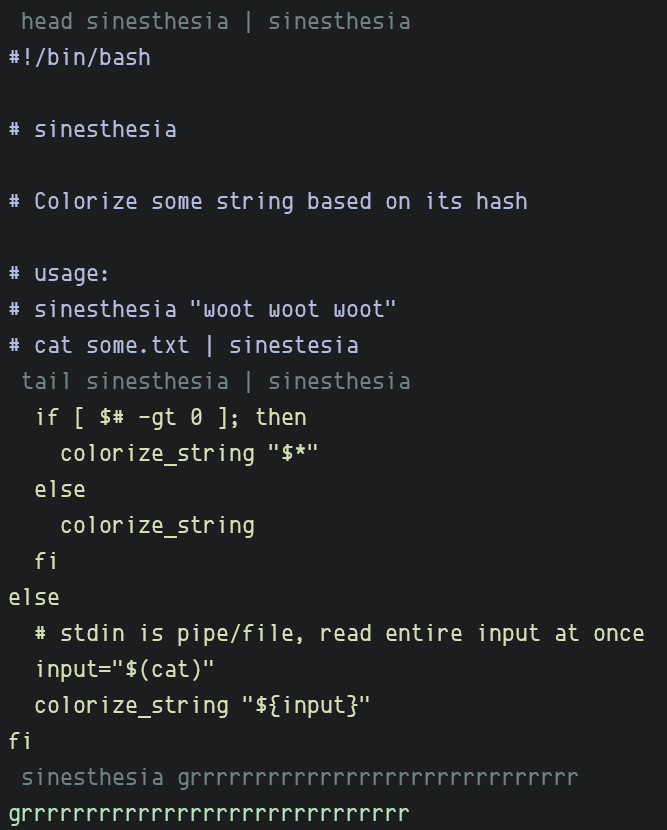Colorize some string based on its hash
30. 5. 2025Proto ↓

#!/bin/bash
# colorizeStringBasedOnHash
# Colorize some string based on its hash
debug="0"
if [ -z "$1" ]; then
string="$RANDOM-$$"
else
string="$1"
fi
hash="$(echo "$string" | md5sum | cut -d ' ' -f 1)"; (( debug )) && echo "hash=${hash}"
red=$((16#${hash:1:2})); (( debug )) && echo "red=${red}"
grn=$((16#${hash:3:2})); (( debug )) && echo "grn=${grn}"
blu=$((16#${hash:5:2})); (( debug )) && echo "blu=${blu}"
# Some protection for very dark colors needed here
echo -en "\e[38;2;${red};${grn};${blu}m"; echo -en "${string}"; echo -e "\e[0m"
So
./colorizeStringBasedOnHash "bark bark bark bark bark"
should always come out as pink. Run without parameters for random string. Not all terminals will support that (they have to be truecolor or something).
Some thoughts ↓

For the purposes of similar brightness between generated colors one could just do:
- hue from hash (instead of rgb), getting range 0-359 (hue=$(($hash % 360)).
- make sat and light static (sat=someValue, light=someOtherValue)
- Convert that HSL to RGB (see chatgpt generated formulas for that)
Why not just use crc32, which seems to be decimal ↓
echo "woot woot woot" | cksum | cut -d ' ' -f1 ~
3828101319 # =hash
and then just hash % 360 to get a hue.
Notes ↓
Both md5sum and cksum are part of coreutils (should be present on any debianish system). Btw: Speed difference seems insignificant (cksum default crc32 vs md5sum).
HSL edition: sinesthesia ↓
Synesthesia is a neurological condition where stimulation of one sense triggers an involuntary experience in another sense. For example, someone with synesthesia might see colors when hearing music or taste textures. It’s not a medical disorder, but a unique and often fascinating sensory phenomenon.
The script (sinesthesia):
https://raw.githubusercontent.com/brontosaurusrex/bucentaur/refs/heads/master/.experiments/bin/sinesthesia
Usage:
sinesthesia "bark bark"
# or
cat some.txt | sinesthesia
Change:
local sat="20" # 0-100
local light="88" # 0-100
for more/less saturated/light colors. Only hue is now derived from hash.
Usage example from another script ↓
if command -v sinesthesia >/dev/null 2>&1; then
cat "$file" | fmt -w ${width} | sed 's/ \{1,\}/ /g' | sinesthesia
else
cat "$file" | fmt -w ${width} | sed 's/ \{1,\}/ /g'
fi
Scrot ↓

Update: The perceptual brightness ↓
Colors should now be more ‘perceptually balanced’ due to a new awk function added, named ‘gamma_correct’.
ChatGPT explanation:
gamma_correct adjusts RGB colors so they all have roughly the same perceived brightness by converting them to linear RGB, normalizing luminance, and converting back to sRGB.

And another script, colorize based on color names ↓
The script (crayon):
https://raw.githubusercontent.com/brontosaurusrex/bucentaur/refs/heads/master/.experiments/bin/crayon
Usage:
cat sometext.txt | crayon tomato
crayon red "yellow"
Shortened color names should also work:
crayon mato "woot"
# would be the same as
crayon tomato "woot"
Color names sourced from this page.
